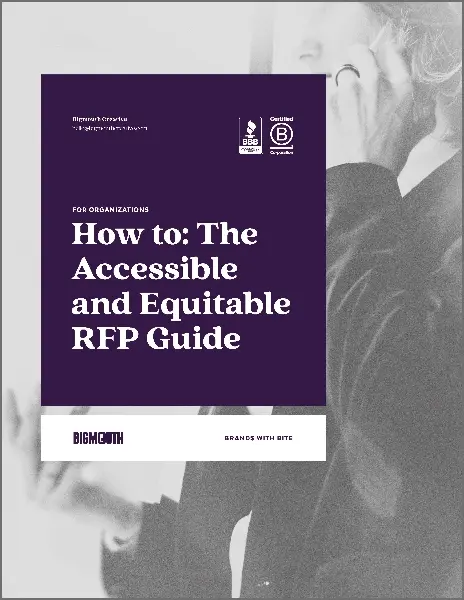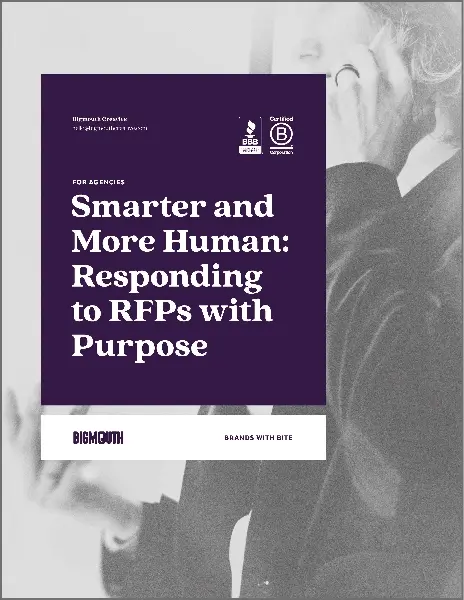RFPs are broken. Here’s how we’d fix them.

At larger organizations, RFPs are created by the procurement department via another department’s request. This department may follow a formulaic process with no opportunity for creativity in the RFP itself.
Government and other organizations in the public sector must follow strict guidelines and regulations. These RFPs may sacrifice clarity of instructions for quantity of information that protects against potential conflicts or vulnerabilities.
Some RFPs are written with a specific type of agency in mind: One the organization has previously hired.
In short: Organizations writing the RFPs can’t get inside the minds of responding agencies. So, Bigmouth is here to show them.
Bigmouth does a lot of work in the public sector, and consequently we respond to a lot of RFXs (shorthand for RFPs, RFIs, RFQs, etc). Submitting these multi-page documents is time-consuming, and not every agency can (or does) throw their hat into the RFP ring. That’s because RFPs:
The organizations who issue RFPs must capitalize on the opportunity to make the response process easier and more equitable for all respondents.
Why should organizations improve their RFP processes?
In the 1999 movie Election, Mr. McAlister (Matthew Broderick) uses a fruit-based analogy to explain the concept of democracy to Paul (Chris Klein).
“Let’s say all you ever knew were apples … you might think apples were pretty good, even if you got a rotten one every once in a while. But then one day, there’s an orange. And now, you can make a decision.”
That’s democracy—and one way organizations benefit from making the RFP process more equitable and accessible. Organizations gain a choice: Go with the large agencies of the past, or open up to smaller, more diverse shops? Apples, or oranges?
Doing this work internally also:
Opens up the talent pool to include smaller agencies, women, minority and/or LGBT businesses
Ensures quality responses—agencies will feel less pressured to rush through enormous documents
Helps your organization review responses and better meet legal and compliance requirements
Builds stronger relationships with vendors (making them more likely to bid again
Fixing your RFPs: Simplify, simplify, simplify
In the ye olde days, complex language and long tomes signified greater intelligence and value. But today’s audiences demand to-the-point messages that convey the most relevant information in a neatly organized format.
Organizations expect agencies to use these tactics to craft successful advertising and marketing. So why not take the same approach when writing their own RFPs?
Ideally, Bigmouth would love to see organizations throw out their old RFPs and start from scratch. We also would love unlimited cookies. Both requests are probably unreasonable.
Instead, here are three easy starting points for more equitable and accessible RFPs:
Provide a clear, concise summary up front, creating a path to accurate responses, and eliminate unnecessary requirements that don’t impact project success. This should include:
• Deadlines
• Formatting requirements
• Word and page limits
• Scoring criteria
Distribute your RFPs through multiple channels—not just large procurement portals.
• Your RFPs should always be available through a free channel
• Partner with chambers, associations or networks to share the opportunities
• Allow adequate time for submission
Create easy opportunities for communication about the RFP. This includes:
• Contact information or a portal/link for Q&As
• Live, recorded information sessions, available for free afterward

Want more detailed guidance?
Download our free guide: How to: The Accessible and Equitable RFP Guide.
Inside, you’ll find direct actions aligned to five important RFP goals — accessibility, transparency, efficiency, equity and relationship-building. We’ve also included a handy checklist to keep your team on track for success.
How agencies can improve their own RFP processes
Small and diverse agencies aren’t waiting around for organizations to choose between apples and oranges. Bigmouth is a certified B corporation, an LGBTQ+ owned business enterprise and a small agency. We’re proud of our human-centric values and environmental stewardship, and want them to shine through in our RFP responses.
Here are a few internal changes we’re implementing to our process:
Getting organized early by familiarizing ourselves with the RFP the day it drops and creating a timeline and to-do list.
Building a shared library of standard RFP content so we can focus on the custom bits.
Sharing only our most relevant samples based on the RFP’s goals, audience and tone.
Proofreading, proofreading, proofreading!
Planning ahead for the details, like scanning, notarizing and uploading multiple files.

Looking for more RFP support?
Download Bigmouth’s free guide for agencies: Smarter and More Human: Responding to RFPs with Purpose.
